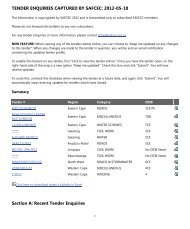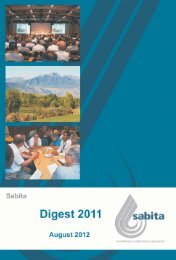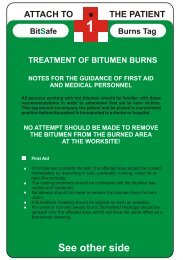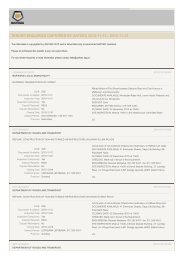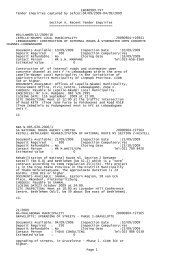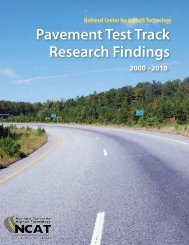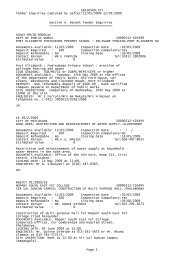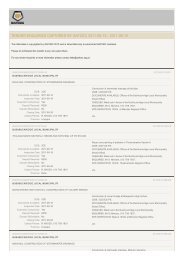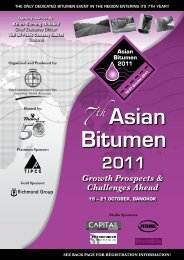DIGEST 2006 - Sabita
DIGEST 2006 - Sabita
DIGEST 2006 - Sabita
You also want an ePaper? Increase the reach of your titles
YUMPU automatically turns print PDFs into web optimized ePapers that Google loves.
oads. These considerations<br />
influence the optimal upgrading<br />
quotient in opposite directions, but<br />
there is no reason to suppose that<br />
they neatly cancel each other out.)<br />
of economic analysis. Let us now<br />
consider the shadow-priced<br />
benefits of road surfacing that<br />
should also be factored into<br />
evaluation.<br />
In any case, this conservative<br />
conclusion arises only prior to<br />
considering other relevant benefits<br />
of paved surfaces and costs of<br />
gravel ones. Before we turn to the<br />
domains where shadow pricing is<br />
concerned, one direct financial<br />
cost factor, which can’t yet be<br />
quantified because it is speculative<br />
but will turn up on public books as<br />
a market price rather than a<br />
shadow price, must be taken into<br />
account. This is that new gravel is<br />
becoming scarce in SA, so its price<br />
is sure to rise.<br />
Municipalities are no<br />
longer allowed to<br />
open new pits without<br />
performing<br />
environmental impact<br />
assessments, which<br />
are beyond the<br />
resource capacity of<br />
most rural<br />
authorities. In<br />
addition, in many<br />
in stances in south ern<br />
Af rica, op ti mal<br />
materials for gravel<br />
roads are con cen trated un der<br />
ar a ble land that has higher<br />
opportunity value as farmland<br />
than as gravel. Thus, on the ba sis<br />
of con struc tion and main te nance<br />
costs alone, we should ex pect the<br />
thresh old for sur fac ing, what ever<br />
ad di tional con sid er ations we use<br />
to determine it, to drop in SA.<br />
However, as noted, accounting for<br />
these costs is only the beginning<br />
Municipalities<br />
are no longer<br />
allowed to open<br />
new pits without<br />
performing<br />
environmental<br />
impact<br />
assessments<br />
• Because of the dust they<br />
spread onto crops, wildlife<br />
and people, gravel roads<br />
impose heavier<br />
environmental costs than<br />
surfaced ones. Dust causes<br />
allergies and respiratory<br />
illness, especially in small<br />
children. People must clean<br />
their homes, businesses and<br />
vehicles more often in dusty<br />
conditions, and this is not a<br />
cost that should be ignored<br />
simply because it is not borne<br />
by the state. It<br />
is, after all, still<br />
borne by the<br />
country on the<br />
dimension that<br />
ultimately<br />
counts for<br />
most, viz.,<br />
reduced<br />
productivity.<br />
Even seemingly<br />
trivial expenses<br />
can produce<br />
high overall<br />
costs when<br />
multiplied by<br />
enough people and hours in<br />
calculating aggregate shadow<br />
prices. To my knowledge, no<br />
one has ever tried to<br />
estimate the costs of road<br />
dust in any jurisdiction. The<br />
task would be quite<br />
demanding. It is surely worth<br />
doing, however, because the<br />
resulting magnitude might be<br />
surprising to many, and thus<br />
might in turn help people not<br />
21



